Branded Content
Tracking community cats and more: How S’pore youth are finding purpose in work and life
They’re channelling their skills, time and energy towards projects that matter to them and their communities

Catsafe, one of 20 youth-led projects showcased at the SG Youth Forum, aims to help protect community cats with smart trackers.
PHOTO: ST FILE
Jan Lee, Brand Newsroom
Follow topic:
She used to track clicks as a former digital marketer. Two years after leaving the corporate world, Ms Charlene Phua is still tracking. But now, her targets have whiskers and four legs.
The 28-year-old left her job in 2023, burnt out and unsure of what to do next. Today, the freelance user experience (UX) designer applies her skills as a volunteer with Catsafe, a youth-led project that leverages smart trackers to alert feeders when community cats go missing.
Ms Phua feels it is meaningful work – helping to protect Singapore’s stray cats at a time when animal abuse cases are at a 12-year high.
There were 961 confirmed cases of animal cruelty and welfare issues in 2024, said the Society for the Prevention of Cruelty to Animals (SPCA).
Ms Phua has always loved cats but never had the chance to own one. She joined Catsafe in July through Better.sg, a volunteer-run charity that supports technology-for-good initiatives. At the time, she was learning UX skills on her own but struggling to find work in a tough market.
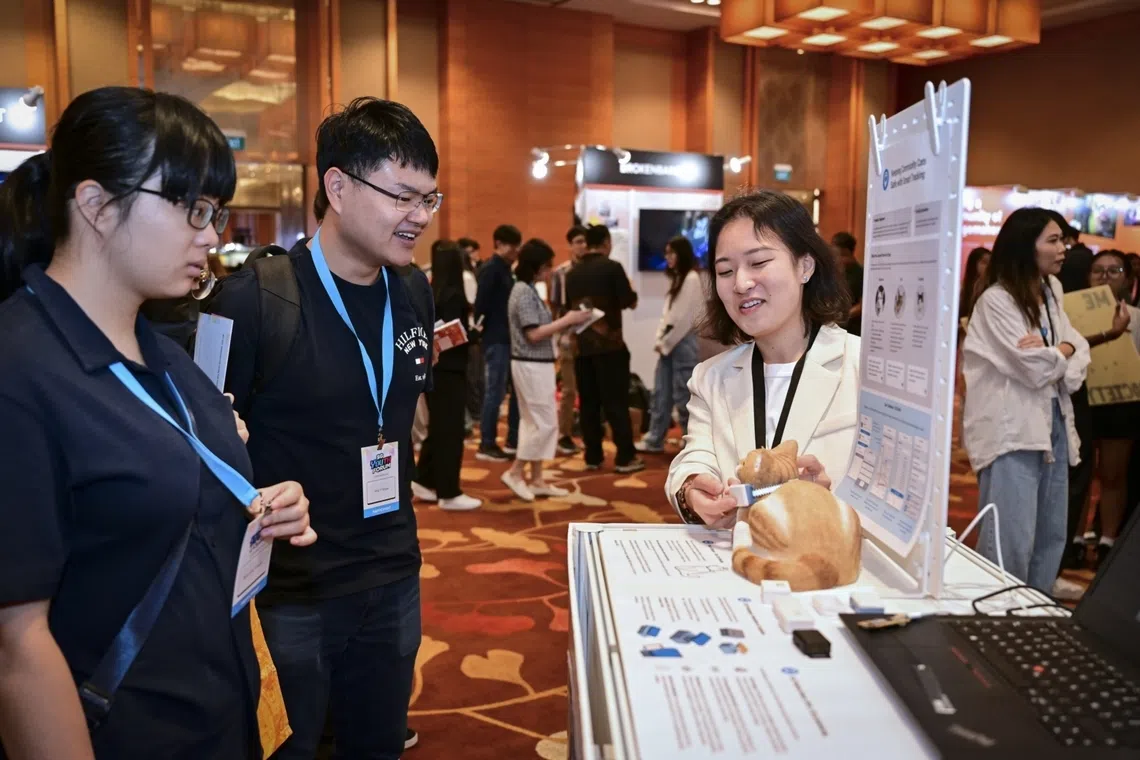
Self-taught UX designer Charlene Phua (right) volunteers with youth-led project Catsafe to help protect the Republic’s stray cats.
PHOTO: CAROLINE CHIA
Catsafe was one of 20 youth-led projects showcased at the SG Youth Forum, under the Young ChangeMakers (YCM) x SG Youth Forum Grant. Teams can pitch their ideas and receive up to $10,000 to implement their projects. Both the event and YCM are organised by the National Youth Council (NYC).
Ms Phua’s search for purpose mirrors a broader shift among her peers: While they care about financial stability, many are equally intent on finding meaning in their work and lives.
That sentiment is captured through engagements under the SG Youth Plan, a five-year action plan that will be developed to support and empower young people on their aspirations, needs and interests.
Spearheaded by the Ministry of Culture, Community and Youth (MCCY) and NYC, more than 200,000 responses were gathered from over 50,000 youth and stakeholders from November 2024 to July 2025.
Among them was Mr Durai Manickam Nizanth, a 21-year-old accountancy student at the Singapore University of Social Sciences.
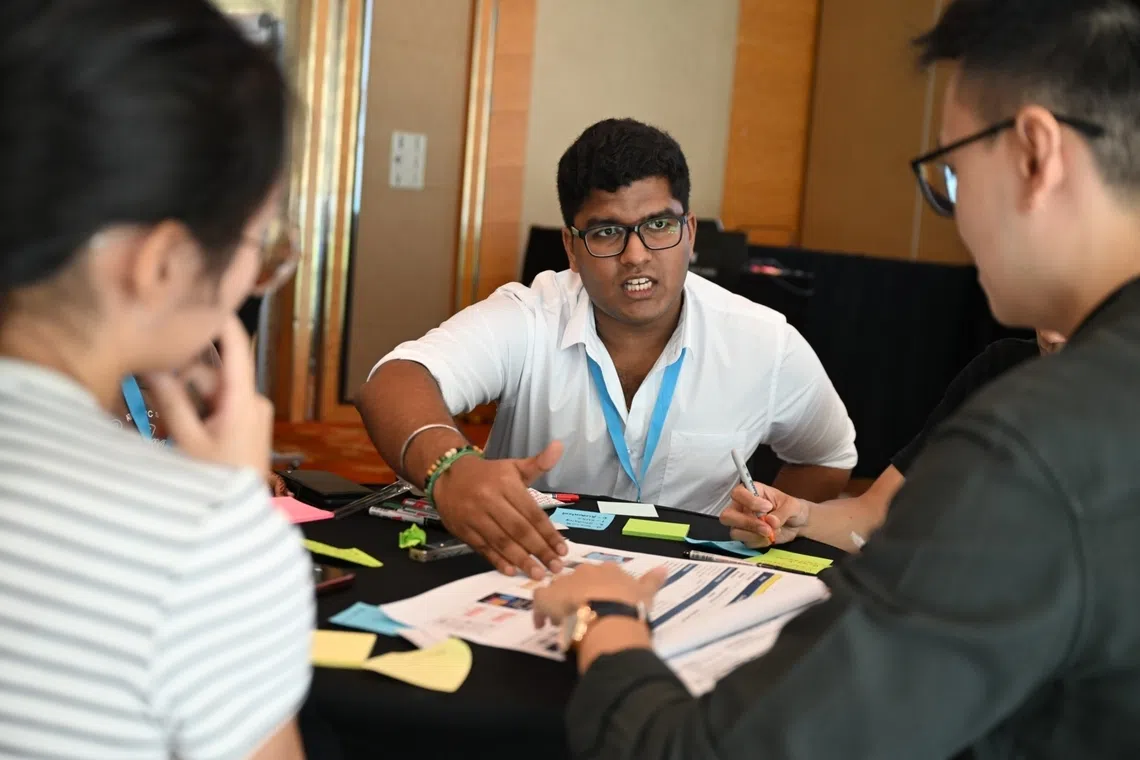
Mr Durai Manickam Nizanth, 21, is passionate about making Singapore a place with equitable opportunities for all. He has been an active youth leader since March 2024.
PHOTO: NATIONAL YOUTH COUNCIL
Growing up in a middle-class family, Mr Nizanth noticed how certain resources were more readily available to some of his peers: He could not afford private tuition while studying for his A-level examinations, and did not have connections who could set him up with an internship after his A levels either.
It sparked his desire for change, and his passion in making Singapore a place with equitable opportunities for people of all backgrounds – not just a privileged few.
“There is more to life than financial success,” says Mr Nizanth, who has been an active youth leader since last March, after a friend invited him to a post-Budget youth engagement.
“Seeing my views be valued and taken up for action makes me feel like I can integrate myself into society… and spark meaningful change.”
In a speech at the SG Youth Forum, Mr David Neo, Acting Minister for Culture, Community and Youth and Senior Minister of State for Education, noted that young Singaporeans are concerned about bread-and-butter issues like careers, finances and housing. At the same time, they yearn for purpose in their work and lives.
Many young people seek to redefine success, he added. “You challenge us to rethink what it means to be successful. You take the road less travelled. You take ownership of your aspirations. You make time for learning opportunities, and you actively seek out new skills and knowledge.”
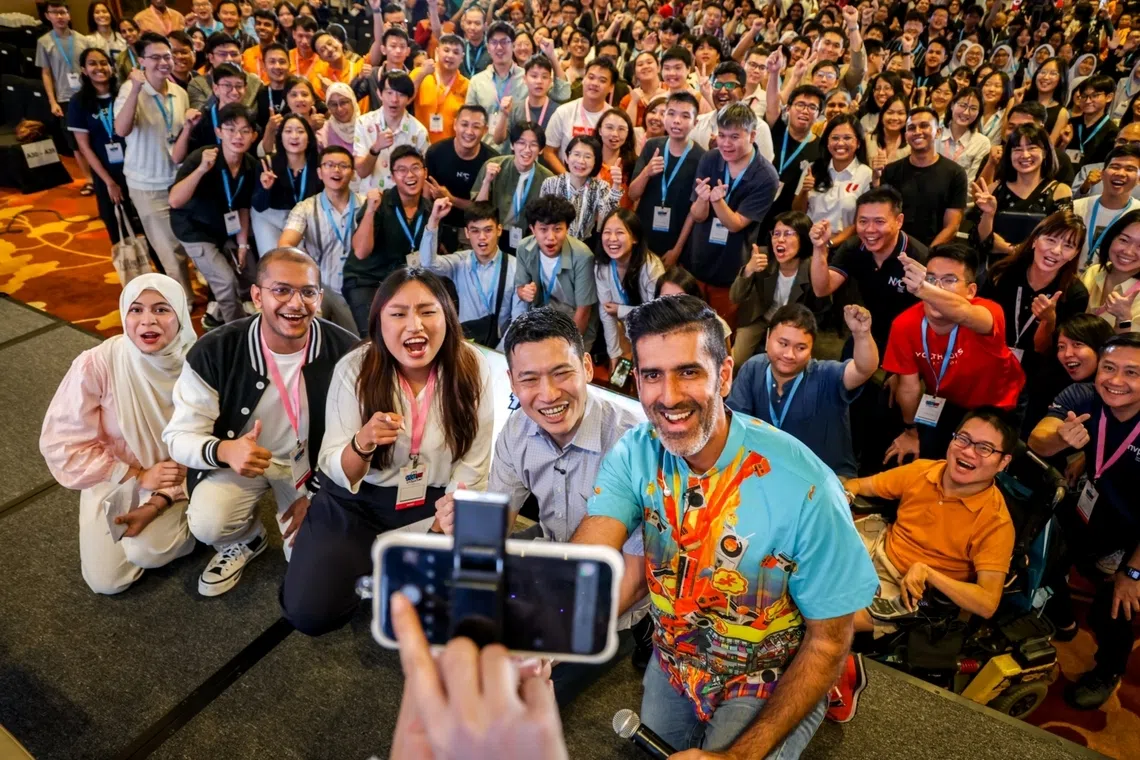
About 1,300 youth and stakeholders attended the SG Youth Forum on Sept 6, which featured a panel dialogue with Acting Minister for Culture, Community and Youth David Neo (second from right).
PHOTO: CMG
Against a global backdrop of growing individualism, what stands out is young people’s strong desire to contribute back to society, he observed. This echoes Prime Minister Lawrence Wong’s call for a “we first” society
So what do the young want, and what does a society that puts “we” before “me” look like? Here’s a look at the key sentiments gathered through the SG Youth Plan surveys.
They care about purpose
>2 in 3
Young people in the survey involving 50,000 youth and stakeholders say they want to find fulfilment and purpose in their work60%
Close to 60 per cent wish for a Singapore that celebrates non-traditional success, encourages risk-taking and embraces failure
Young people care about how they use their time and effort.
This same sense of purpose guides local coffee company Bettr and its social mission. Ms Suyin Tay, assistant director at its training arm Bettr Academy, says the brand’s social programme provides at-risk youth with job skills.
Her team of 20 at Bettr Academy trains them as baristas while developing their emotional and social skills, before giving them work placement opportunities. Since its launch in 2011, more than 320 marginalised individuals aged between 15 and 60 have been trained.
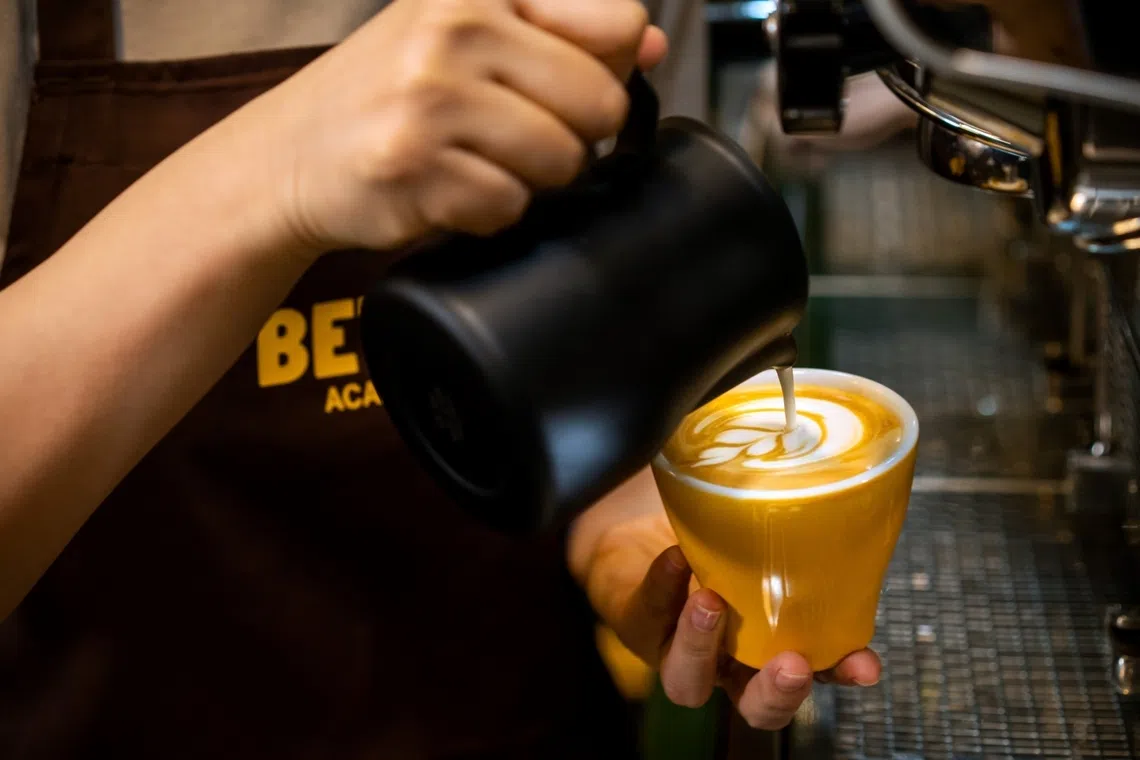
Bettr Academy, the training arm of local coffee company Bettr, provides at-risk youth with job skills.
PHOTO: BETTR GROUP
The 35-year-old former educator once taught literature and history in a secondary school. She understands what it feels like to change course in her career – and how purposeful work can be life-changing.
“Young people want a sense of belonging,” she says. “Oftentimes, when they struggle, it’s because they lack community. When they take part in unsavoury activities, it is usually because that activity was done within a community.
“Having dignified work is one way to help youth with community. Work is such a big part of our lives, and if someone suffers from an unsafe home, or maybe dropped out of school, then their next strongest community is work.”
They want to contribute
>1 in 2
Young people surveyed as part of SG Youth Plan say they aspire to be active volunteers>50%
Say they want to make a positive impact on their community
The sentiments gathered by NYC show that young people are keen to contribute to their community and society.
For a group of aspiring doctors at the National University of Singapore (NUS), that positive impact begins with seniors’ health.
Mr Siddarth Venkateswaran, Mr Lai Haoxiang and Mr Chen Haoyang are a trio of 23-year-old final-year medical students at NUS. They started Project HealthSync in early 2025 with NUS School of Computing students to help seniors prevent sarcopenia.
Sarcopenia, or muscle loss, can make it difficult to do things like walking if not properly managed.
The initiative grew out of a community project the trio started in October 2022, concerned about what staying indoors during the Covid-19 pandemic meant for the health of Singapore’s elderly.
They conducted health screenings for adults aged 50 and above in community centres in Toa Payoh and found that many seniors were at risk of sarcopenia. Nearly one-quarter of Toa Payoh residents are aged 65 and above
“Fortunately, there are simple interventions to prevent sarcopenia, like diet and guided exercise,” Mr Siddarth said.
Along with the NUS School of Computing students, the Project HealthSync team has come up with a motion capture camera device to help prevention. When one does simple exercises like body weight squats in front of the device, there will be prompts to ensure that one’s posture is proper – mimicking the experience of having a physiotherapist.
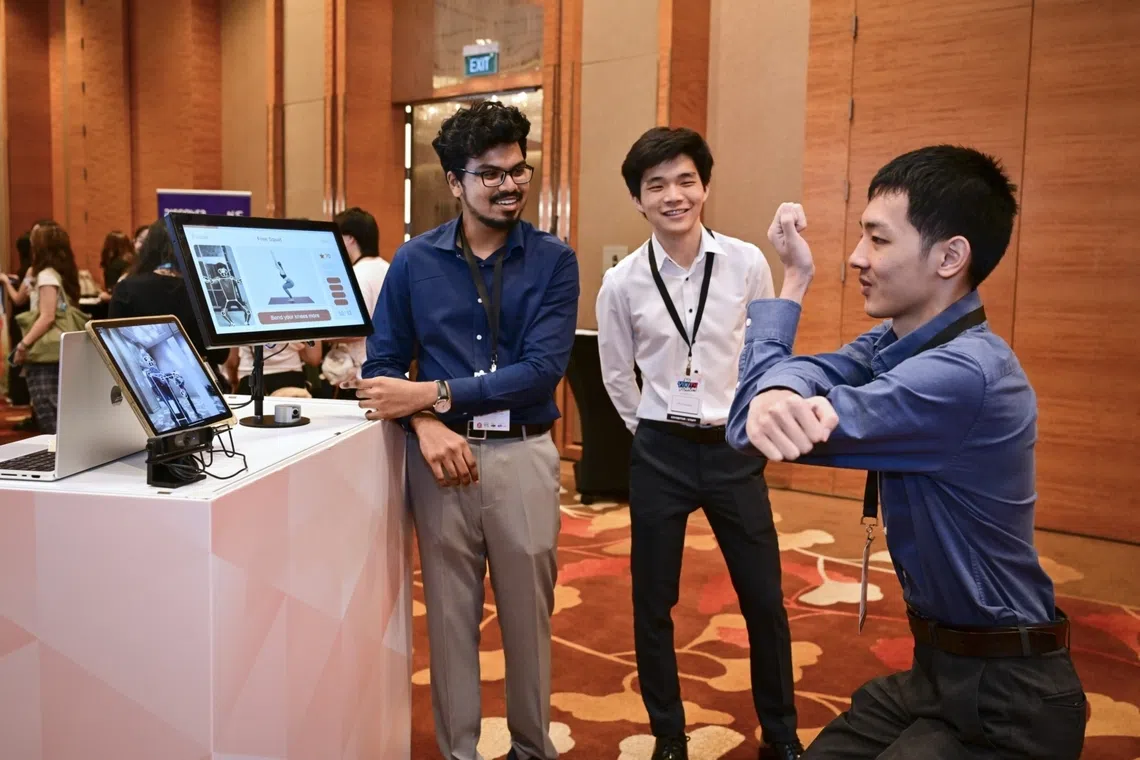
The Project HealthSync team hopes to help seniors prevent sarcopenia, or muscle loss, with their motion capture camera device which guides seniors on simple exercises.
PHOTO: CAROLINE CHIA
They hope to set these devices up at active ageing centres, and also include a leaderboard function, which ranks how well and consistently seniors are doing these exercises in relation to their peers.
Project HealthSync is another youth-led initiative under NYC’s Young ChangeMakers (YCM) programme. The trio wants to use the grant to pilot the devices at Toa Payoh, and eventually roll it out to more districts around Singapore.
Mr Chen explains: “Our goal is to make preventive healthcare accessible and empower seniors to exercise, and by gamifying it, hopefully it is more fun for the seniors and encourages them to push each other to be more consistent and better at doing their exercises.”
How can young people like them start doing more for their communities? “When we first started the project,” says Mr Siddarth, “we were just targeting all aspects of health with a broad screening and only found our niche of sarcopenia prevention midway.
“I think sometimes people feel a bit of apprehension to venture out of their comfort zones. But don’t be afraid. If you have an idea, just explore it and see where it takes you.”
They yearn to connect
>6 in 10
Young people surveyed say they envision Singapore as a cohesive society with diverse and inclusive communities where people care for one another and treat each other with kindness and empathy
Aside from caring and contributing, young people are also looking to foster more meaningful connections with people from all walks of life.
Hwa Chong Institution student Guo Jiarong believes that connection could mean bridging the gap between the deaf and hearing communities.
The 17-year-old became intrigued by Singapore Sign Language (SgSL) after watching videos about it online. SgSL is the sign language used in Singapore. “I thought it was really interesting how words are not necessary for them to communicate and interact, and they are just using their gestures and hands,” she says.
In 2024, when she was still studying at Nanyang Girls’ High School, she and her friends started Project Coral Hearts as a community project to foster understanding and inclusion between deaf and hearing residents.
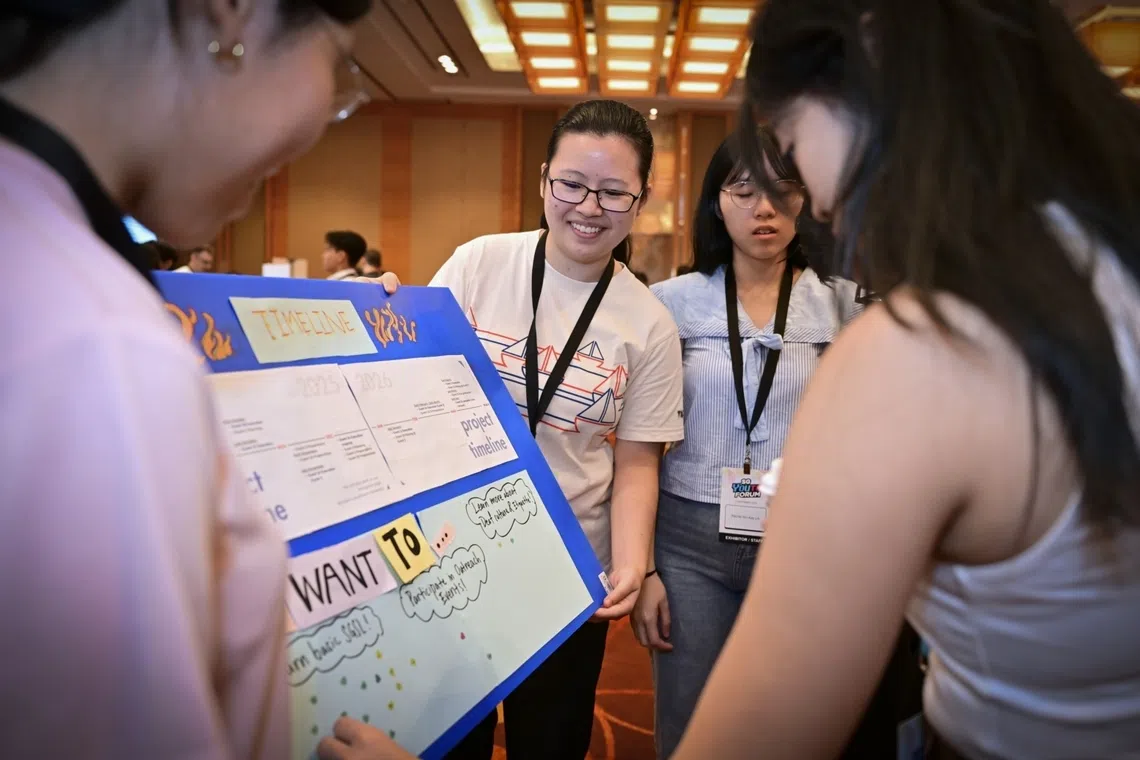
Ms Guo Jiarong (centre) of Project Coral Hearts s helping to build connections between the deaf and hearing communities in Singapore.
PHOTO: CAROLINE CHIA
Ms Guo says: “There are organisations for the deaf community in Singapore, but a lot of the work is centred within the deaf community. We want to get the hearing community involved as well.”
The Coral Hearts team, which currently has 13 members, is self-taught in SgSL. They ran two month-long virtual sign language courses in June 2024 and March 2025. Most of the 40 participants across both courses were secondary school, polytechnic and junior college students.
Both courses concluded with outreach events in partnership with Touch Silent Club, a non-profit organisation for the deaf community. Held at Touch Community Services’ headquarters in Bukit Merah, the events brought deaf and hearing individuals together for activities like crocheting, clay modelling and cooking.
The team, which is also part of the YCM programme, hopes to organise more of such events if they win the grants.
To Ms Guo, a cohesive society needs in-person connection.
“Nowadays, there’s such a dependence on online platforms for connection. But it’s important to step outside. Maybe take a walk around your neighbourhood, or take a bus somewhere.
“There’s so much to learn in our own communities.”
Get involved in the SG Youth Plan
As Singapore marks its 60th year of independence, the country is looking beyond just economic growth, but at a more important question: What kind of home do Singaporeans want to build?
This question sits at the heart of the SG Youth Plan, a five-year action plan that aims to support and empower young people on their aspirations, needs and interests.
Initiated by the National Youth Council, the SG Youth Plan will outline how young people can take action to do good for Singapore, when armed with opportunities, platforms and resources. It also details ideas for how different segments of society can play a part in empowering youth to be the best versions of themselves.
The plan has gathered more than 200,000 responses from over 50,000 youth and stakeholders from November 2024 to July 2025.
Singaporeans and permanent residents aged 15 and above can contribute to the SG Youth Plan through its quest page ( go.gov.sg/join-sgypquest
Each month, participants stand a chance to win prizes including lifestyle, shopping and travel vouchers worth up to $300 through a lucky draw. The plan will not directly attribute any inputs to any members of the public.
Those keen to show up at in-person events can also see the schedule of youth engagement activities at go.gov.sg/attend-sgyp
In partnership with the National Youth Council

